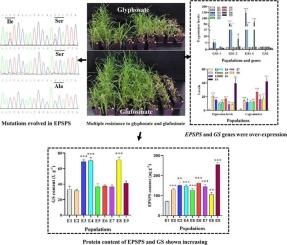Unraveling the mechanisms of multiple resistance across glyphosate and glufosinate in Eleusine indica
IF 4
1区 农林科学
Q2 BIOCHEMISTRY & MOLECULAR BIOLOGY
引用次数: 0
Abstract
The herbicides glyphosate and glufosinate are commonly used in citrus and sugarcane orchards in Guangxi Province, China, wherein the C4 plant Eleusine indica (L.) Gaertn. is known to be a dominant weed species. However, high selection pressure has resulted in failure of control. In the present study, experiments were conducted to clarify resistance levels for the suspected populations and elucidate the mechanisms for multiple resistance. The resistance index to glyphosate was calculated for eight populations and ranged from 5.4 to 21.3, with a low-level shikimate content of 0.24–0.50 μg g−1. In addition, three populations showed low-level resistance to glufosinate, with a resistance index ranging from 2.6 to 3.9. The amplification of the 5-enolpyruvylshikimate-3-phosphate synthase (EPSPS) gene with a double-mutation T102I + P106S (TIPS) or a single-mutation (P106S and P106A) was observed in most populations. The target genes of glufosinate (GS1–1, GS1–2, and GS1–3) showed high-level expression, namely 145.5-fold that of susceptible plants. The content of EPSPS and glutamine synthetase (GS) protein in resistant plants can reach to 3.6 and 2.1 times higher than those in susceptible plants, respectively. The overexpression of the EPSPS gene with double (T102I + P106S) or single (P106S and P106A) mutations, plus the overexpression of GS1–1, GS1–2, and GS1–3, responded to multiple resistance mechanisms. Altogether, these results demonstrate that overexpression of GS1 is a novel form of resistant mechanism to glufosinate in weeds.

揭示榄香属植物对草甘膦和草铵膦的多重抗性机制
除草剂草甘膦和草铵膦常用于中国广西省的柑橘园和甘蔗园,其中 C4 植物 Eleusine indica (L.) Gaertn.是已知的优势杂草物种。然而,由于选择压力大,导致无法控制。本研究通过实验明确了疑似种群的抗性水平,并阐明了多重抗性的机制。计算了 8 个种群对草甘膦的抗性指数,范围在 5.4 至 21.3 之间,低水平莽草酸含量为 0.24-0.50 μg g-1。此外,三个种群对草铵膦表现出低水平抗性,抗性指数在 2.6 至 3.9 之间。在大多数种群中,5-烯醇丙酮酰莽草酸-3-磷酸合成酶(EPSPS)基因的扩增出现了 T102I + P106S 双突变(TIPS)或单突变(P106S 和 P106A)。草铵膦的靶基因(GS1-1、GS1-2 和 GS1-3)表现出高水平的表达,是易感植物的 145.5 倍。抗性植株的 EPSPS 和谷氨酰胺合成酶(GS)蛋白含量分别是易感植株的 3.6 倍和 2.1 倍。过表达双突变(T102I + P106S)或单突变(P106S 和 P106A)的 EPSPS 基因,再加上过表达 GS1-1、GS1-2 和 GS1-3,可应对多种抗性机制。总之,这些结果表明 GS1 的过表达是杂草对草铵膦产生抗性的一种新型机制。
本文章由计算机程序翻译,如有差异,请以英文原文为准。
求助全文
约1分钟内获得全文
求助全文
来源期刊
CiteScore
7.00
自引率
8.50%
发文量
238
审稿时长
4.2 months
期刊介绍:
Pesticide Biochemistry and Physiology publishes original scientific articles pertaining to the mode of action of plant protection agents such as insecticides, fungicides, herbicides, and similar compounds, including nonlethal pest control agents, biosynthesis of pheromones, hormones, and plant resistance agents. Manuscripts may include a biochemical, physiological, or molecular study for an understanding of comparative toxicology or selective toxicity of both target and nontarget organisms. Particular interest will be given to studies on the molecular biology of pest control, toxicology, and pesticide resistance.
Research Areas Emphasized Include the Biochemistry and Physiology of:
• Comparative toxicity
• Mode of action
• Pathophysiology
• Plant growth regulators
• Resistance
• Other effects of pesticides on both parasites and hosts.

 求助内容:
求助内容: 应助结果提醒方式:
应助结果提醒方式:


